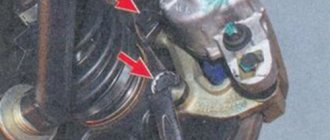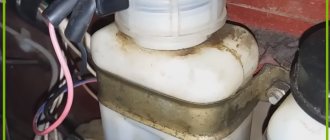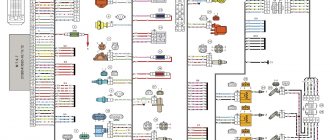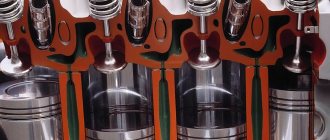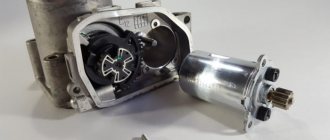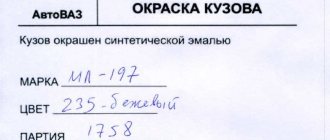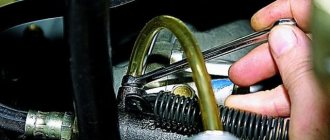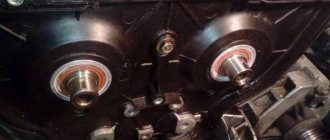Anti-lock braking system ABS: types, types
Depending on the type and type, ABS is classified into:
- One scheme of operation of the ABS system is when all the devices that make up the ABS are located in one unit. That is, the hydraulic valve block, hydraulic accumulator and pump are located in one unit.
- The second ABS scheme is when the component devices (hydraulic valve block, hydraulic accumulator and pump) are located in different places. In this type of braking system, in addition to the ABS module, there is also an ESP module and an SBC module.
Bleeding the brake system
| Bleed the brake system while wearing safety glasses. If brake fluid accidentally gets into your eyes, rinse them immediately with plenty of water and seek medical attention! |
| The hydraulic system is pumped in order to remove air from it that enters the system when servicing the brake mechanisms, replacing hydraulic lines or the turbocharger, as well as when the fluid level in the master cylinder reservoir drops below the minimum permissible value. |
| Models with ABS |
Useful tips
How to bleed ABS brakes on Priora, Kalina and Honda Civic correctly? To prevent the work from causing harm to your car, and you don’t have to take it to a car service center, you should remember a few rules. Self-replacement of brake fluid for Lada Priora. Step-by-step writing of the work with illustrations.
Firstly, you do not need to turn on the ignition for more than 15-20 seconds. Otherwise, this will lead to failure of the electric pump. Secondly, it is necessary to take breaks between pumping the wheels. After all the air (aired mixture) has come out of one wheel, you should not immediately move to the second. You need to wait about 5-10 minutes until the air in the system completely disappears.
- Why does the electric power steering turn off on a Kalina? Replacing the electric power steering control unit
- Fuse block Kalina 2, its diagram, assignment of all fuses and relays (21925, 21927 Lux)
- Vaz Kalina tire sizes - Size tables
- How to tighten the handbrake on Kalina or replace its cable
Possible brake malfunctions and solutions
Increased brake pedal travel:
– Leakage of brake fluid from the wheel cylinders
Replace failed parts of wheel cylinders, wash and dry pads, discs and drums, bleed the hydraulic drive system
– Air in the brake system
Remove air from the system
– Damaged rubber O-rings in the master cylinder
Replace the rings and bleed the system
– Damaged rubber hoses for hydraulic brakes
Replace the hoses and bleed the system
– Increased runout of the brake disc (more than 0.15 mm)
Sand the disc; if the disc thickness is less than 10.8 mm, replace it
– Fluid leakage through the O-rings of the pressure regulator pusher
Replace O-rings
Insufficient braking performance:
– Oiling of brake pad linings
Clean the pads with a wire brush using warm water and detergent. Eliminate the cause of fluid or grease getting on the brake pads
– Jamming of pistons in wheel cylinders
How to properly bleed ABS brakes
To achieve a good result, you will need an assistant, with whom you first need to bleed the brake system of the front wheels, then the rear ones.
Important! There can be high pressure in the brake system, up to 180 atmospheres, so you must first relieve the pressure.
You can bleed, that is, reduce the pressure by discharging the pressure accumulator. To discharge the pressure accumulator, you need to turn off the ignition and press the brake pedal many times (about 20 times).
After this, you need to disconnect the connectors on the brake fluid reservoir. If suddenly, while driving, in a front-wheel drive car, bad sounds begin in the area of the front wheels: grinding, crunching sounds, then these are most likely signs of a CV joint malfunction.
The brakes are bled when it is necessary to remove air from the brake system. This often happens when replacing brake fluid, which is done approximately every 50-60 thousand km. mileage or once every 2 years.
It is also necessary to bleed the brakes after repairing the brake system: replacing the master cylinder or vacuum brake booster. The need for bleeding also arises when depressurization occurs due to damage to the hoses, or when the liquid in the expansion tank drops below the minimum mark.
The pedal will indicate that you need to bleed the brakes - it will become soft and begin to sink. And the brakes themselves will become more sluggish. However, this could also indicate a more serious problem with the brake rotor or pads. So, if bleeding does not help, perhaps you should still contact a specialist - brakes are no joke!
Zonovsergey › Blog › Bleeding brakes with ABS on Lada Priora
The braking system is a very important factor for traffic safety. The Priora, like other cars, has a hydraulic brake system. In addition, many of the cars are equipped with an anti-lock braking system. This means that it is necessary to carefully monitor the fluid level in the expansion tank and the absence of air pockets in the tubes and components. And bleed the system in a timely manner.
BRAKE SYSTEM DEVICE
The Priora brake system includes the following elements:
master brake cylinder; fluid reservoir; piping system; working cylinders – 4 pcs.; brake drums; master cylinder vacuum; brake pedal. master brake cylinder As on all cars, the brakes on the Priora are pneumohydraulic. What it looks like in practice. The main part of the brake system is the master cylinder. It is located in the engine compartment. A container with an oily liquid is connected to it. It is called “braking”. The main brand used on Priora was Dot. It is widespread among Russian car enthusiasts and is well known to those who have tried to bleed the brakes. The master cylinder is filled with this liquid and acts like a syringe. When you press the brake pedal in the cabin, the piston of the master cylinder pushes the fluid in it into the pipeline system. Those, in turn, are connected to the working cylinders. Acting on the same principle, the working cylinder forces the locking pads to compress or, conversely, depending on the type of brake, to unclench, stopping the rotation of the wheels.
Braking requires quite a lot of effort from the driver. Making such an “injection” and bleeding the brakes on four wheels at once is not an easy task. Therefore, a solution was found: due to the vacuum in the intake system, a special mechanism, a vacuum, greatly facilitates this process. And the pedal is quite easy to press.
Important! It is the system, operating on the “syringe” principle, with many rubber seals, that requires the complete absence of air in the system, since its presence reduces the efficiency of the brakes to zero. Simply put, due to the difference in the density of air and brake fluid, instead of uniform pressure on the piston of the working cylinder, there will be a chaotic movement of air bubbles inside the system. Because of this, they sometimes need to be pumped.
FEATURES OF BRAKES WITH ABS (ANTI-LOCK BRAKING SYSTEM)
After the creation of the first hydraulic brakes, it soon became clear: completely jamming the wheels with pads does not improve braking performance at all. Moreover, it creates dangerous drifts. At first, drivers were taught jerk braking, that is, not keeping the pedal pressed constantly, but “pumping” by releasing and pressing the pedal with high frequency. The method is not very effective, because in critical situations, most drivers press the brake pedal firmly to the floor. And the same ABS was developed that is found on many Priora models.
PRINCIPLE OF OPERATION OF ABS
The basis of ABS, as in all systems of modern cars, is a computer. It is he who controls all the actions of the anti-blocker. ABS is practically built into the Priora braking system. The fluid from the main cylinder enters the “hydraulic unit”, in which the ECU (electronic control unit), pressure control valves and ERP (electric return pump) are mounted. In accordance with the signals from the wheel speed sensors, the ECU opens and closes the valves and, releasing pressure, creates the very necessary jerky “pumping” effect. Even if the driver presses the pedal without releasing it.
HOW TO BLEND THE BRAKES ON A PRIOR
The purpose of bleeding the brake system is to completely fill all devices and pipes with brake fluid. With a complete absence of air jams and bubbles. There is a special procedure for this, called bleeding the brakes.
Attention! It can only be done by two people. To perform this you will need the following tools and devices:
special key for the valve (bleeder fitting); transparent container for draining brake fluid; a thin flexible hose for fitting onto the working cylinder fitting; 1 – 1.5 liters of DOT brake fluid.
The process of bleeding the Priora brakes must be carried out in an inspection pit or on a lift. This procedure is carried out either after any repair of the brake system, or during the annual technical inspection of the car. Also, if suddenly there is a feeling that the brake is not working correctly, you feel the pedal sinking or, conversely, jamming without braking.
STARTING THE UPGRADING PROCESS
So, the Priora needs to be driven into a pit or lifted onto a lift. One person must be behind the wheel to apply the brakes, the second must work under the car. You must first check the brake fluid level in the expansion tank. If there is not enough of it, add it. In general, before bleeding the brakes on a Priora, you need to make sure that there is more fluid in the expander than the usual norm. That's it, the liquid is filled, now you need to pump it.
It usually starts from the front left wheel. On the inside of the wheel rim (hub) you can see a valve - a fitting for the working cylinder. It is closed with a special rubber cap. It is necessary to remove the cap and place a rubber tube on the nipple. Place the other end of the tube into a transparent container filled with brake fluid. Prepare a special key for the valve. The driver must fully press and release the brake several times and pump until the Priora pedal is at the highest point.
Then the person at the bottom of the wheel must release the valve with a key and release the pressure in the working cylinder. In this case, you need to carefully watch the liquid, watching for air bubbles escaping, while not releasing the pedal. And as soon as it falls to the floor, tighten the valve. Pump in this way several times. You must wait until there is no more air in the escaping brake fluid. Then you need to drain the liquid for the last time and fix the valve. Place the cap and check the brake fluid level in the reservoir.
Now repeat the same procedure completely, bleed the brakes on the right front wheel. Do everything the same way.
Attention! Do not forget to add brake fluid to the expansion tank. Under no circumstances should it be empty, so check after each wheel. After bleeding the brakes of the right front wheel, you need to go back and bleed the brakes first on the rear left, and then on the rear right wheel. The brake pumping cycle for the rear wheels is 1.5 times longer, that is, if it is enough to pump the cylinder 3 times at the front, then the rear wheels need to be pumped at least 5 times. After this, finally add brake fluid to the Priora expansion tank, check the tightness of the bypass valves and the presence of protective caps. That's it, field tests can be carried out. Drive a short distance and check the brakes at low speed.
FEATURES OF PUMPING BRAKES ON A PRIOR WITH ABS
There is no difference in this process for Priora. Both with and without ABS, the operating algorithm remains the same. Pump it the same way and check the result.
ABS bleeding sequence
- First, we look for and remove the fuse in the fuse block that is responsible for the operation of the anti-lock braking system.
- Next, we jack up and remove one front wheel, and look for the brake wheel cylinder (BWC) fitting.
- After this, we put a hose on the fitting (from a hydraulic level, for example).
- Open the fitting one turn.
- One presses the brake pedal all the way and holds it in that position.
- Now turn the ignition key to turn on the hydraulic pump (the ABS indicator lights up on the instrument panel).
- The second person watches how air is removed through the hose and, after removing the air, tightens the fitting.
- We release the brake pedal only after tightening the fitting.
- Now, how do you know that all the air has escaped from the ABS? This shows the ABS icon on the dashboard, if it goes out after removing the air and tightening the fitting, then all the air has escaped.
There is a special order for properly bleeding an anti-lock brake system: right front wheel, then rear, then rear right, and then rear left wheel. If during such work the fuel fluid leaks out of the system, it is necessary to fill the system with new fluid. And to do this, you need to know what fluids can be mixed and how much brake fluid is needed to replace.
practical guide
Working brake system of a Lada Priora with ABS:
1 — brake mechanism of the front left wheel; 2, 5, 13, 18 — brake hoses; 3, 8, 12, 19 — brake pipes; 4 — main brake cylinder; 6 — brake mechanism of the front right wheel; 7 — front right wheel speed sensor; 9 — reservoir of the main brake cylinder; 10 - vacuum booster; 11 — brake pedal; 14 — rear right wheel rotation sensor; 15 — brake mechanism of the rear right wheel; 16 — master disk of the rear left wheel speed sensor; 17 — brake mechanism of the rear left wheel; 20 - ABS hydraulic modulator
Note: The left brake mechanisms are also equipped with wheel speed sensors, which are not visible in the figure. On a vehicle not equipped with an anti-lock braking system, a fluid pressure regulator is built into the hydraulic rear brake actuator.
The car is equipped with two braking systems - working and parking.
The service braking system is designed to reduce the speed of the vehicle until it comes to a complete stop and briefly hold the vehicle stationary.
The service brake system is dual-circuit, diagonal, hydraulically driven, and consists of a master cylinder with a vacuum booster, four wheel brakes and a fluid pressure regulator in the rear brakes. The front wheel brakes are disc, non-ventilated, the rear wheels are drum.
Each of the car’s circuits includes brake mechanisms of two wheels (one front and one rear), located diagonally on the car. One circuit includes the brake mechanisms of the front right and rear left wheels, and the second circuit includes the brake mechanisms of the front left and rear right wheels. If one of the circuits fails, the second circuit, although with less efficiency, will ensure that the car stops.
The fluid pressure regulator limits the flow of fluid to the rear brake mechanisms when there is insufficient load on the rear axle, thereby preventing the rear wheels from locking and the rear axle of the vehicle from skidding during sudden braking. The regulator body has a control hole closed with a plastic plug. Liquid leakage from this hole indicates leakage of the regulator rings.
Special device for bleeding brakes
In this episode of Technical Environment, its host Gennady Emelkin will talk about how to replace it yourself.
| Models with ABS |
https://www.youtube.com/watch?v=ytabout
The disadvantage of old brakes was that one or more wheels would lock when the pedal was pressed to the floor. As a result, the car lost control and skidded, especially on slippery roads. Later, the traditional system was modernized by adding the following elements:
- hydraulic valve block;
- electric pump;
- capacity - hydraulic accumulator;
- wheel rotation sensors;
- electronic control module (ECU).
The listed components and parts are components of the anti-lock braking system. Thanks to them, a car with ABS never skids, since the automatic system simulates repeated sharp presses on the brake pedal, although the driver presses it all the way.
There are 2 types of brake circuits on cars: three- and four-channel. In the first case, the front wheels are connected to the main brake cylinder by separate branches, and the two rear wheels are connected by a single circuit. In the second scheme, each wheel has its own liquid line.
To understand the difference between bleeding a brake system with ABS, it’s worth understanding its operation:
- When the driver brakes under normal road conditions, the sensors on the wheels record approximately the same deceleration (taking into account turning) and the ABS does not manifest itself at all.
- When you press the pedal sharply, one or more wheels lock and rotate slower than the others, which the sensor reports to the ECU.
- At the command of the controller, the hydraulic unit opens the corresponding valve and the pressure in the circuit of the stopped wheel drops. Excess brake fluid flows into a storage tank.
- The pads release the disc (or drum) and the wheel spins along with the rest. But since the goal is to brake quickly, the ECU switches the valves again, the pads “grab” and hold the disc until the sensor detects the lock again. The cycle repeats until it stops completely.
- To prevent pressure in the master cylinder from dropping during valve actuation, an electric pump replenishes the brake fluid by pumping it from the hydraulic accumulator.
One described cycle takes a fraction of a second. The interaction of the fluid circuits with ABS is felt when the pedal is fully depressed. Due to the rapid operation of the valves and the pumping of fluid, the driver feels a series of shocks.
Conclusion
After carrying out repair and maintenance work on critical components of the car, before driving, you must first check the tightness of the system and the operability of the vehicle components.
ABS - Anti-lock Braking System is a system against wheel locking during heavy braking. Thanks to the fact that ABS prevents the car from skidding along the road, safety increases in emergency situations. The anti-lock braking system will operate correctly if the system is not air-filled.
https://www.youtube.com/watch?v=ytadvertise
Watch this helpful video. Tests show that even a working ABS system turns off at the end of the braking distance, so you still need to modify it with your foot.


